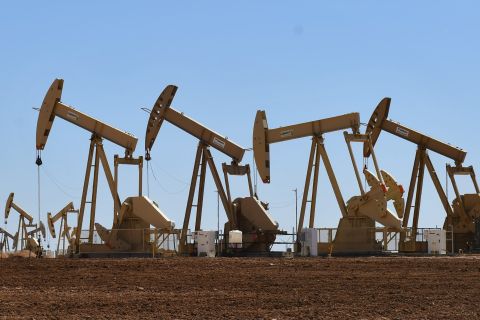
The $40 million Vero Beach Nopetro Eco District project will initially produce 3 million gallons of RNG. (Source: Nopetro Energy)
Florida-headquartered Nopetro Energy is adding another cog to its “circular” clean energy operations as it captures methane from municipal landfill waste to create renewable natural gas (RNG). The gas is then turned into CNG to fuel public transit and fleets.

The company recently started construction on a landfill gas-to-RNG facility in southern Florida, marking the first for the region and the second for the state. The $40 million Vero Beach Nopetro Eco District project will initially produce 3 million gallons of RNG. Construction is expected to be completed in early 2025.
“Renewable natural gas really provides a remarkable opportunity for communities to not only eliminate harmful emissions in terms of biogas that’s currently being flared, whether it’s a wastewater treatment plant or a landfill, but it also allows for a native source of natural gas production,” Nopetro Energy CEO Jorge Herrera told Hart Energy.
Production of the clean energy resource is seen as another way to harden the grid, while also creating a new revenue stream for municipalities and counties open to partnering with private companies.
Municipal solid waste landfills are the third-largest source of methane emissions generated by human activity in the U.S., according to the U.S. Environmental Protection Agency (EPA). In 2022, the EPA said methane emissions from landfills were equivalent to the greenhouse-gas emissions from more than 24 million gasoline-powered passenger vehicles driven for a year.
RNG, which is produced from biogas with feedstock sources such as landfill waste and wastewater, is formed when contaminants are removed from methane to elevate the gas into pipeline quality gas that is used in the same ways as fossil gas. The carbon intensity of RNG can be considerably lower than fossil gas, though it varies depending on the feedstock used. The fuel source is seen as a promising route to help lower greenhouse gas emissions and green up grids.

RELATED
One Man's Trash? Treasure of RNG Prospects Available for Waste Facilities
Earlier this year, Deloitte reported that only 225 of the 1,641 publicly owned municipal landfills in the U.S. capture biogas through anaerobic digestion. Captured biogas is used mostly to generate electricity. Just 28 landfills produce RNG, Deloitte said in a report.
Nopetro is among the companies seizing opportunities. The company aims to produce about 2 million MMBtu of RNG annually, which Herrera said the company expects to reach within 36 months.
The company, which owns or operates about 16-17 compressed natural gas fueling facilities, has a unique operating model, according to Herrera, who cofounded the company in 2008. It’s a producer, offtaker and distributor.
“About 50% of the country’s solid waste sector has transitioned the garbage trucks, the refuse fleets, over to compressed natural gas,” Herrera said. “On the transit bus [side], you’ve got about a third roughly of the country’s transit system running on compressed natural gas. So, because we own and or operate compressed natural gas fueling facilities, we effectively are our offtake.”
The company is working with municipalities such as those in Florida’s Indian River County where the landfill gas-to-RNG production facility is being built.
“Once we produce renewable natural gas in for example, Indian River County, we will inject it into the pipeline and then we will send it to our facilities and will be able to distribute renewable natural gas to, say, the Central Florida Transit system, the city of Orlando, Orange County … It’ll be a truly circular operation here in Florida where we’ll get to turn our waste, our trash into fuel, into renewable natural gas. And then we'll get to use that same fuel to power busses and trucks in the in the state of Florida.”
He also sees opportunity to use RNG for power generation.
In the U.S. and Canada, 338 RNG production facilities are in operations, according to the Coalition for Renewable Natural Gas. Another 165 are under construction and 324 in development. Nearly three-quarters of the RNG volumes use municipal solid waste as feedstock.
The growing industry is not without its challenges.
“One of the more difficult challenges is there’s a lot of stakeholders that are involved in these projects. You’re going to have municipalities. You’re going to have utilities. You’re going to have the local distribution companies that have franchises in that area,” Herrera said. “So, you've got multiple parties that need to collaborate constructively in a way to push a project forward.”
Having necessary infrastructure and pipelines in place — and ideally having feedstock within a five-mile radius of production — is also important, he added.
While RNG is less carbon intense than fossil natural gas, it remains more expensive. State and federal incentives, including multiple tax credit options, have improved economics.
“From the federal government, the Inflation Reduction Act was very beneficial to the industry, allowing for these projects to come to the market in a quick and expeditious manner,” Herrera said. “So, these are all different mechanisms that we have to be able to produce renewable natural gas and make the projects work.”

At its Vero Beach facility, Nopetro plans to produce about 450,000 MMbtu per year of RNG, which equates to roughly 3 million gallons of gasoline on an energy equivalent basis. The project has been more than two years in the making.
The facility is expected to be commissioned by November or December and become fully operational in first-quarter 2025.
“The objective is to turn all our nation’s waste resources into energy. I believe that there is an enormous opportunity from both an economic perspective, but also from a societal perspective, in terms of being able to repurpose our waste and convert that into energy,” Herrera said. “It seems like a natural evolution for humanity to be able to accomplish that objective. And now with science and technology reaching the levels that they’ve reached today, it’s actually possible.”
Recommended Reading
EIA: Permian, Bakken Associated Gas Growth Pressures NatGas Producers
2024-04-18 - Near-record associated gas volumes from U.S. oil basins continue to put pressure on dry gas producers, which are curtailing output and cutting rigs.
Life on the Edge: Surge of Activity Ignites the Northern Midland Basin
2024-04-03 - Once a company with low outside expectations, Surge Energy is now a premier private producer in one of the world’s top shale plays.
CEO: EQT Positioned to Meet Demand of Power-guzzling AI Data Centers
2024-04-01 - EQT Corp.’s Toby Rice said demand for AI could exceed the power demand required to meet U.S. residential demand and jump 20% by 2030, in this Hart Energy Exclusive interview.
Gulfport Plans Liquids-rich Program After ‘Strong’ Ohio Oil Tests
2024-05-01 - Appalachia gas producer Gulfport Energy continues to report “strong oil production” from a two-well Hendershot pad drilled in eastern Ohio last year. Gulfport plans to develop additional liquids-rich opportunities this year as natural gas prices hover near record lows.
Enverus: Permian Gains Will Sustain US Oil Production Through 2030
2024-05-09 - Crude output gains from the Permian Basin will keep U.S. oil production relatively flat entering the 2030s, offsetting declines from mature oily basins, according to Enverus Intelligence Research.






